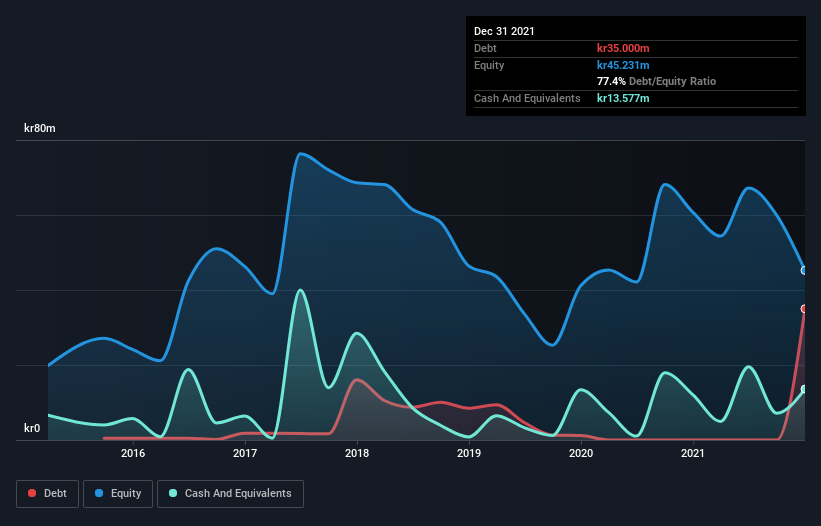Howard Marks put it nicely when he said that, rather than worrying about share price volatility, 'The possibility of permanent loss is the risk I worry about... and every practical investor I know worries about.' So it seems the smart money knows that debt - which is usually involved in bankruptcies - is a very important factor, when you assess how risky a company is. Importantly, BrainCool AB (publ) (NGM:BRAIN) does carry debt. But the real question is whether this debt is making the company risky.
When Is Debt A Problem?
Debt assists a business until the business has trouble paying it off, either with new capital or with free cash flow. Ultimately, if the company can't fulfill its legal obligations to repay debt, shareholders could walk away with nothing. While that is not too common, we often do see indebted companies permanently diluting shareholders because lenders force them to raise capital at a distressed price. Of course, the upside of debt is that it often represents cheap capital, especially when it replaces dilution in a company with the ability to reinvest at high rates of return. The first step when considering a company's debt levels is to consider its cash and debt together.
Check out our latest analysis for BrainCool
What Is BrainCool's Net Debt?
The image below, which you can click on for greater detail, shows that at December 2021 BrainCool had debt of kr35.0m, up from none in one year. However, it also had kr13.6m in cash, and so its net debt is kr21.4m.

A Look At BrainCool's Liabilities
According to the balance sheet data, BrainCool had liabilities of kr54.1m due within 12 months, but no longer term liabilities. On the other hand, it had cash of kr13.6m and kr2.70m worth of receivables due within a year. So it has liabilities totalling kr37.8m more than its cash and near-term receivables, combined.
Of course, BrainCool has a market capitalization of kr371.7m, so these liabilities are probably manageable. However, we do think it is worth keeping an eye on its balance sheet strength, as it may change over time. When analysing debt levels, the balance sheet is the obvious place to start. But you can't view debt in total isolation; since BrainCool will need earnings to service that debt. So when considering debt, it's definitely worth looking at the earnings trend. Click here for an interactive snapshot.
In the last year BrainCool wasn't profitable at an EBIT level, but managed to grow its revenue by 73%, to kr28m. With any luck the company will be able to grow its way to profitability.
Caveat Emptor
Even though BrainCool managed to grow its top line quite deftly, the cold hard truth is that it is losing money on the EBIT line. Indeed, it lost kr35m at the EBIT level. Considering that alongside the liabilities mentioned above does not give us much confidence that company should be using so much debt. So we think its balance sheet is a little strained, though not beyond repair. However, it doesn't help that it burned through kr35m of cash over the last year. So suffice it to say we consider the stock very risky. When analysing debt levels, the balance sheet is the obvious place to start. But ultimately, every company can contain risks that exist outside of the balance sheet. For example, we've discovered 6 warning signs for BrainCool (2 can't be ignored!) that you should be aware of before investing here.
If, after all that, you're more interested in a fast growing company with a rock-solid balance sheet, then check out our list of net cash growth stocks without delay.
Valuation is complex, but we're here to simplify it.
Discover if BrainCool might be undervalued or overvalued with our detailed analysis, featuring fair value estimates, potential risks, dividends, insider trades, and its financial condition.
Access Free AnalysisHave feedback on this article? Concerned about the content? Get in touch with us directly. Alternatively, email editorial-team (at) simplywallst.com.
This article by Simply Wall St is general in nature. We provide commentary based on historical data and analyst forecasts only using an unbiased methodology and our articles are not intended to be financial advice. It does not constitute a recommendation to buy or sell any stock, and does not take account of your objectives, or your financial situation. We aim to bring you long-term focused analysis driven by fundamental data. Note that our analysis may not factor in the latest price-sensitive company announcements or qualitative material. Simply Wall St has no position in any stocks mentioned.
About OM:BRAIN
BrainCool
A medical device company, together with its subsidiaries, engages in the development, marketing, and sale of medical cooling systems for the healthcare sector in Sweden.
High growth potential with excellent balance sheet.
Similar Companies
Market Insights
Community Narratives



